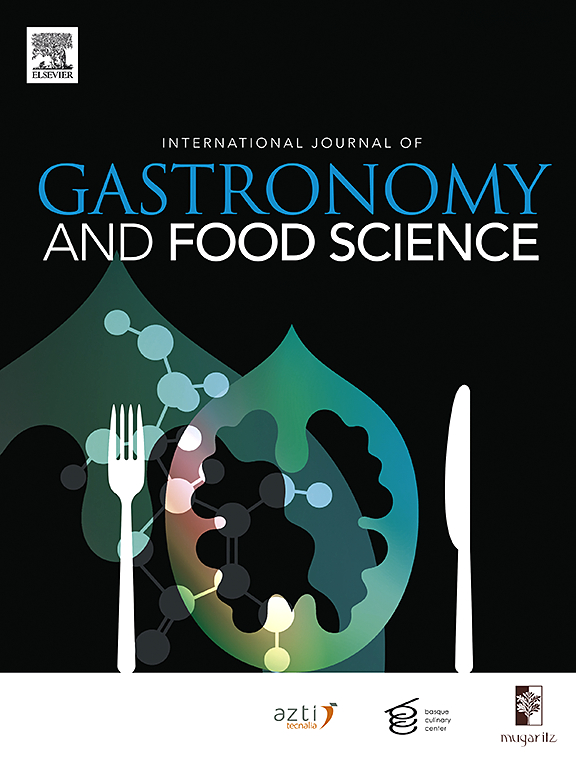Fresh fish consumption: The impact of fish yield on the financial performance of a fine dining restaurant
IF 3.6
2区 农林科学
Q2 FOOD SCIENCE & TECHNOLOGY
International Journal of Gastronomy and Food Science
Pub Date : 2025-06-21
DOI:10.1016/j.ijgfs.2025.101232
引用次数: 0
Abstract
This proposal examines the impact of fresh fish consumption on the financial performance of a fine dining restaurant, with a focus on international tourists. Fish, as the main ingredient of the restaurant's best-selling dish, also represents one of its highest costs. The primary objective of the study is to prioritise the sale of species that generate the highest financial return, focusing on contribution margin and the application of menu engineering concepts.
Three species were analysed: Sandperch (Pseudopercis Numida), Acoupa Croaker (Cynoscion Acoupa) and Snowy Grouper (Hyporthodus Niveatus), chosen by the chef based on their accessibility to customers, seasonality, size, and price. These species must ensure flavour, tenderness, and juiciness throughout the preparation stages, which include grilling and roasting. The fish are purchased whole and gutted, weighing between 10 and 12 kg, and are measured using an electronic scale. Smaller weights render the product unviable due to insufficient yield for dish preparation.
An analysis revealed that the lowest cost per portion is not necessarily associated with the lowest price per kilogram of fish. The study includes a detailed assessment of purchasing, preparation, and filleting processes, focusing on cost-per-portion calculations and the contribution margin analysis for each species.
The case study approach aligns with the Sustainable Development Goals (SDGs), particularly regarding the use of natural resources such as fishing, as it emphasises respect for species seasonality and the application of methods to maximise raw material usage while minimising waste. These practices are crucial to achieving broader sustainability goals.
Practical application
Strategies that balance fish quality and profitability.
鲜鱼消费:鱼类产量对高档餐厅财务业绩的影响
本提案考察了鲜鱼消费对一家高级餐厅财务绩效的影响,重点是国际游客。鱼肉作为这家餐厅最畅销的一道菜的主要原料,也是成本最高的一种。该研究的主要目标是优先考虑产生最高财务回报的物种的销售,重点关注贡献利润率和菜单工程概念的应用。分析了三种鱼类:沙鲈(Pseudopercis Numida)、棘鱼(Cynoscion Acoupa)和雪石斑鱼(hypthodus Niveatus),由厨师根据它们的可及性、季节性、大小和价格选择。这些品种必须确保在整个准备阶段,包括烤和烤的味道,嫩度和多汁。购买的鱼是整条取出内脏的,重量在10到12公斤之间,用电子秤测量。较小的重量使产品无法生存,因为没有足够的产量为菜肴准备。一项分析显示,每份鱼的最低成本并不一定与每公斤鱼的最低价格相关。该研究包括对采购、准备和切片过程的详细评估,重点是每部分成本的计算和每种物种的贡献边际分析。案例研究方法与可持续发展目标(sdg)保持一致,特别是在渔业等自然资源的使用方面,因为它强调尊重物种的季节性,并采用最大限度地利用原材料的方法,同时最大限度地减少浪费。这些做法对于实现更广泛的可持续发展目标至关重要。实际应用平衡鱼类质量和利润的策略。
本文章由计算机程序翻译,如有差异,请以英文原文为准。
求助全文
约1分钟内获得全文
求助全文
来源期刊

International Journal of Gastronomy and Food Science
Social Sciences-Cultural Studies
CiteScore
5.30
自引率
10.50%
发文量
170
审稿时长
45 days
期刊介绍:
International Journal of Gastronomy and Food Science is a peer-reviewed journal that explicitly focuses on the interface of food science and gastronomy. Articles focusing only on food science will not be considered. This journal equally encourages both scientists and chefs to publish original scientific papers, review articles and original culinary works. We seek articles with clear evidence of this interaction. From a scientific perspective, this publication aims to become the home for research from the whole community of food science and gastronomy.
IJGFS explores all aspects related to the growing field of the interaction of gastronomy and food science, in areas such as food chemistry, food technology and culinary techniques, food microbiology, genetics, sensory science, neuroscience, psychology, culinary concepts, culinary trends, and gastronomic experience (all the elements that contribute to the appreciation and enjoyment of the meal. Also relevant is research on science-based educational programs in gastronomy, anthropology, gastronomic history and food sociology. All these areas of knowledge are crucial to gastronomy, as they contribute to a better understanding of this broad term and its practical implications for science and society.
 求助内容:
求助内容: 应助结果提醒方式:
应助结果提醒方式:


